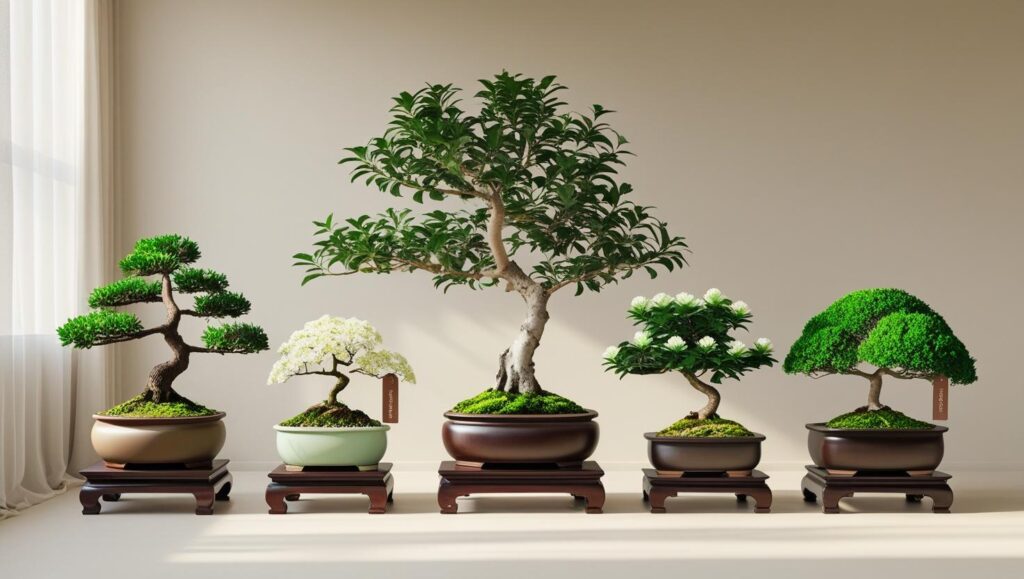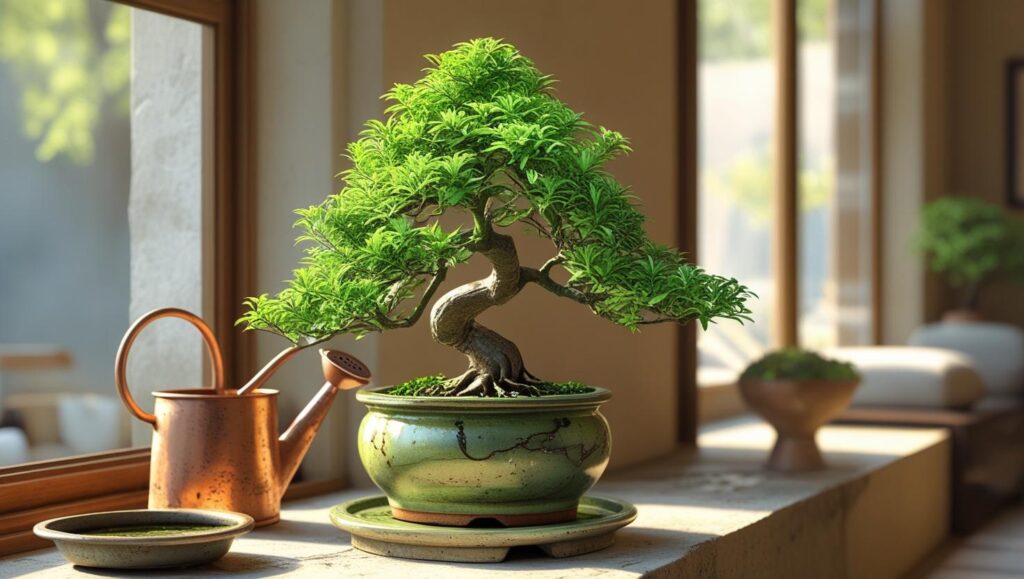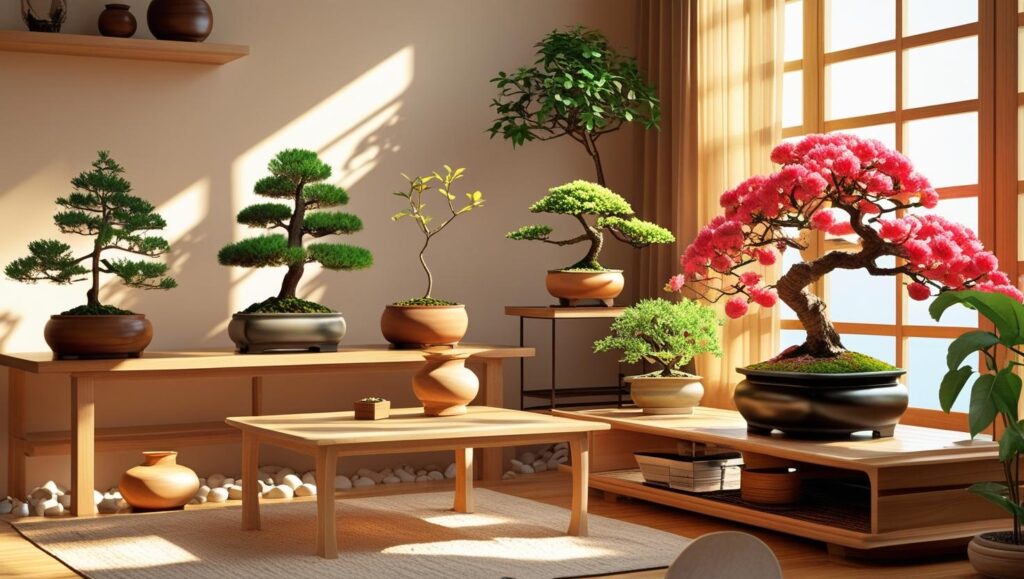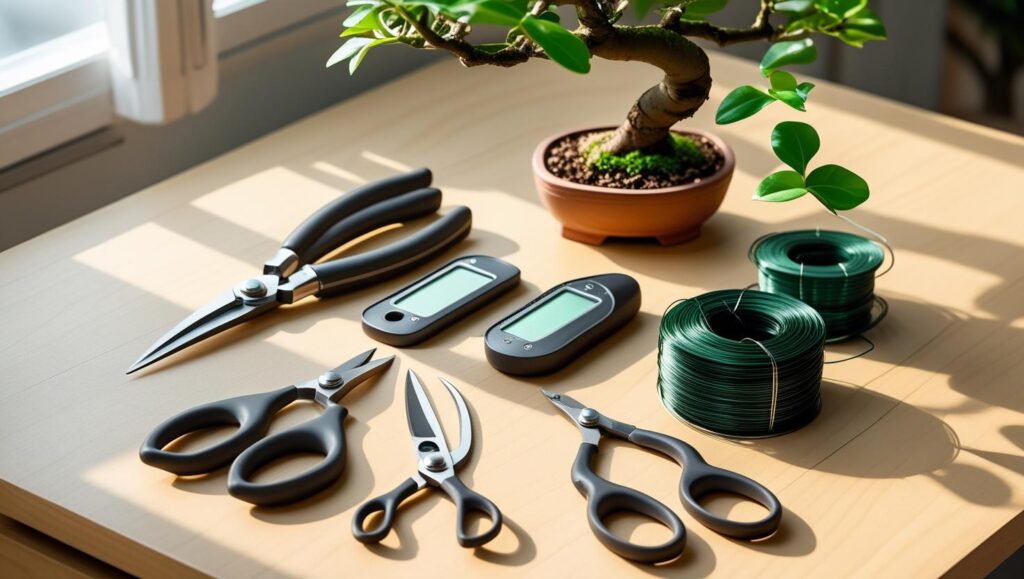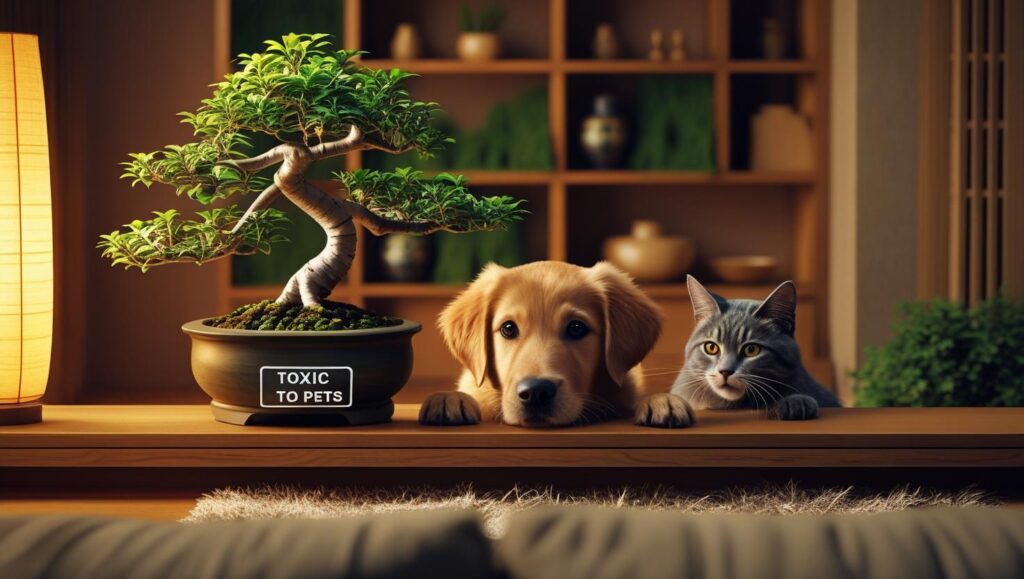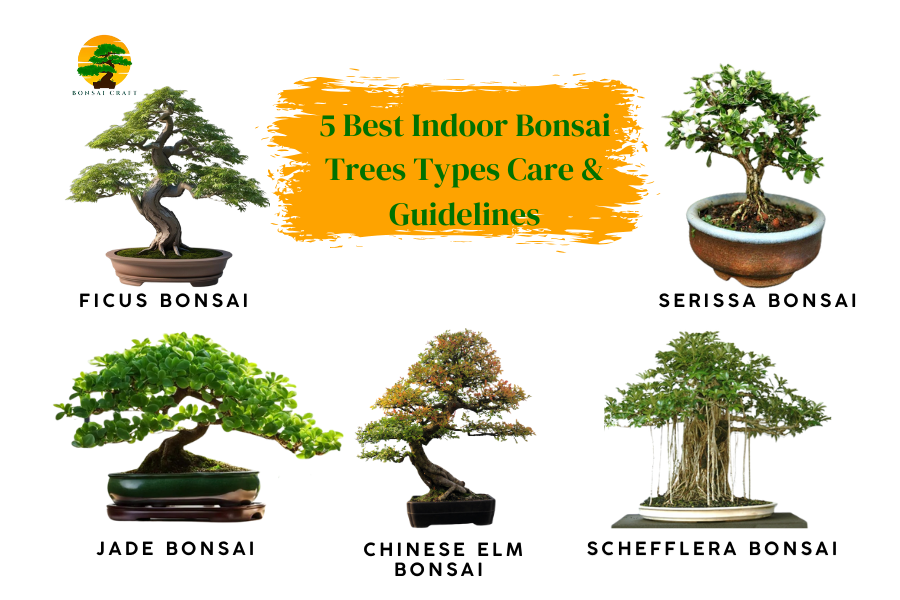
Indoor Bonsai Trees offer a perfect blend of artistry and nature, bringing a touch of serenity to your home or office. Their miniature forms encapsulate the beauty of full-sized trees, while their care demands patience and precision, making them both a challenge and a joy for enthusiasts. If you’re new to bonsai or looking to expand your indoor garden, this comprehensive guide will cover everything you need to know about indoor bonsai trees, from choosing the right species to mastering their care.
What Is an Indoor Bonsai Tree?
An indoor bonsai tree is a miniature version of a full-sized tree, grown indoors using bonsai techniques. It mimics the natural shape and style of trees, offering a peaceful addition to indoor spaces. An indoor bonsai tree is a small tree cultivated indoors using bonsai techniques. These trees are grown to mimic the appearance of full-sized trees, but in miniature form, making them ideal for indoor spaces. Bonsai trees can come from various species, including Ficus, Jade, and Chinese Elm, among others.
Their compact size makes them suitable for homes, apartments, and offices. Though they are small, these trees require special care, including proper lighting, watering, pruning, and soil maintenance. Indoor bonsai trees are unique in that they must be shaped and maintained to encourage growth, making them a perfect hobby for those seeking mindfulness and patience.
Why Are Indoor Bonsai Trees Popular for Home Decor?
Indoor bonsai trees are popular for their beauty, ability to purify air, and the mindfulness they encourage. They add tranquility to any space.
- Aesthetic appeal: Adds elegance and serenity.
- Air purification: Improves indoor air quality.
- Mindfulness: Cultivating bonsai promotes focus and patience.
Indoor bonsai trees are widely appreciated for their aesthetic appeal. They serve as peaceful focal points in any room and are ideal for home decor, adding a natural element to interior spaces. The artistic appeal of these miniature trees makes them a standout in homes or offices. In addition to their beauty, indoor bonsai trees also help improve air quality. They naturally purify the air by absorbing carbon dioxide and releasing oxygen, promoting a cleaner environment.
Growing bonsai trees also fosters a sense of mindfulness. The process of caring for them—pruning, shaping, and watering—requires patience and attention, encouraging a calming and meditative experience. Overall, these trees offer more than just visual beauty; they help create a serene atmosphere, reduce stress, and connect individuals with nature, even in indoor settings.
What Are the Best Indoor Bonsai Tree Species?
Top indoor bonsai tree species include Ficus, Chinese Elm, Jade Bonsai, and Serissa Bonsai, all suited for indoor care.
|
Species |
Ease of Care |
Size |
| Ficus Bonsai |
Easy |
Small to medium |
| Chinese Elm Bonsai |
Moderate |
Medium |
| Jade Bonsai |
Easy |
Small |
| Serissa Bonsai |
Moderate |
Small |
| Schefflera Bonsai |
Easy |
Medium |
When selecting the best indoor bonsai trees, it’s essential to choose species that thrive in indoor environments. The Ficus Bonsai is one of the best indoor bonsai species, known for its low maintenance and adaptability to low light. It’s perfect for beginners and can tolerate a range of indoor conditions. The Chinese Elm Bonsai is also an excellent choice, offering a delicate appearance and resilient nature.
The Jade Bonsai is a hardy species that requires minimal water and is excellent for beginners who want a low-maintenance bonsai. The Serissa Bonsai, also known as the Tree of a Thousand Stars, is known for its small, fragrant white flowers, making it a beautiful addition to your collection, though it requires a bit more care and attention. Each of these species offers something unique and can thrive indoors with proper care.
Which Bonsai Trees Are Easiest to Grow Indoors?
The easiest bonsai trees to grow indoors include Ficus, Jade, and Chinese Elm. These species are hardy and require minimal maintenance.
For beginners, it’s best to start with bonsai trees that are easy to care for indoors. The Ficus Bonsai is one of the easiest bonsai trees to grow indoors. It is adaptable to a range of indoor conditions, tolerates low light, and requires minimal pruning. Jade Bonsai is another excellent option. As a succulent, it thrives with little watering and prefers bright, indirect light.
Its thick leaves help retain moisture, making it perfect for those who may forget to water occasionally. The Chinese Elm Bonsai is also beginner-friendly. It has a resilient nature and can survive in a variety of indoor environments, making it ideal for those new to bonsai care. These three species are great for those starting their bonsai journey, offering easy care while still showcasing the beauty of bonsai trees.
How to Take Care of an Indoor Bonsai Tree (Step-by-Step Guide)
To care for an indoor bonsai tree: Water when the topsoil is dry, provide 4-6 hours of indirect light, prune regularly, and fertilize monthly during the growing season.
Caring for an indoor bonsai tree requires consistent attention. Follow these steps for successful bonsai care indoors:
- Watering: Water the tree when the top layer of soil feels dry. Make sure the pot has good drainage, and avoid letting the tree sit in excess water.
- Lighting: Indoor bonsai trees need 4-6 hours of indirect sunlight daily. Place the tree near a bright window but out of direct sunlight to avoid leaf burn.
- Pruning: Regular pruning helps maintain the tree’s shape and promotes new growth. Trim branches and leaves carefully with bonsai scissors.
- Fertilizing: Use a balanced liquid fertilizer once a month during the growing season (spring and summer) to support growth.
- Humidity: Keep the humidity high by misting the tree or placing it on a humidity tray.
By following these steps, your indoor bonsai tree will thrive and add natural beauty to your space.
How Much Light Does an Indoor Bonsai Tree Need?
Bright indirect sunlight is best for indoor bonsai trees. Place them near a window with filtered light. Most indoor bonsai trees need 4-6 hours of indirect sunlight each day. Direct sunlight can burn the delicate leaves of your bonsai tree indoors, so it’s best to place your tree near a window with filtered light or use sheer curtains to diffuse the sunlight. In case natural light is insufficient, you can supplement the light with grow lights designed for indoor plants.
Be sure to adjust the positioning of the tree if it shows signs of insufficient light, such as leggy growth or leaf drop. Keeping your indoor bonsai tree in an area that provides the right amount of light ensures that it grows healthily and maintains its vibrant colors.
How Often Should You Water an Indoor Bonsai Tree?
Water when the topsoil feels dry – about every 2–3 days. Make sure the pot drains well to prevent root rot. Water your indoor bonsai tree when the topsoil feels dry to the touch. Typically, this will be about every 2-3 days during the warmer months. In the winter, reduce the watering frequency as the tree enters dormancy. Be sure to check the soil before watering—if it’s still moist, wait until it dries out a little more.
Overwatering can lead to root rot, so it’s essential that the pot has good drainage. Allow excess water to drain from the bottom of the pot. Always discard any water that accumulates in the saucer to avoid soggy roots. By maintaining a consistent watering schedule, your indoor bonsai tree will thrive.
What Type of Soil Is Best for Indoor Bonsai?
Use well-draining soil specifically designed for bonsai trees. A mix of akadama, pumice, and lava rock is ideal for indoor bonsai trees. Choosing the right soil is crucial for indoor bonsai trees. The soil needs to drain properly while still holding enough moisture for the roots. Akadama, pumice, and lava rock are the most common ingredients used in bonsai soil mixes. These materials create an ideal environment for bonsai trees indoors, ensuring proper aeration and drainage.
Akadama retains some moisture but allows excess water to escape, while pumice improves drainage and provides aeration to the soil. Lava rock helps stabilize the soil and promotes root health. A typical soil mix should consist of 40% akadama, 30% pumice, and 30% lava rock. This mix provides the right balance of water retention and drainage, preventing waterlogged soil, which can lead to root rot. Repotting every 2-3 years with fresh soil ensures continued healthy root development.
What Fertilizer Should You Use for Indoor Bonsai Trees?
Use balanced liquid fertilizer once a month during the growing season to nourish your indoor bonsai tree. Fertilizing your indoor bonsai tree is essential to keep it healthy and encourage growth. During the growing season (spring and summer), use a balanced liquid fertilizer with equal parts of nitrogen, phosphorus, and potassium, like a 20-20-20 mix. Apply it once a month to promote healthy foliage and strong root development. Be sure to dilute the fertilizer according to the manufacturer’s instructions to avoid overfeeding, which could damage the tree.
In fall and winter, when the tree is in a dormant state, reduce or stop fertilizing altogether. Over-fertilizing during dormancy can stress the tree. Additionally, if your bonsai is kept in poor soil or hasn’t been repotted for a while, you may want to apply a slow-release fertilizer or organic compost to enrich the soil. Regular feeding ensures your indoor bonsai tree grows strong and vibrant.
What Are the Most Common Mistakes with Indoor Bonsai Trees?
Common indoor bonsai mistakes include overwatering, insufficient light, wrong pruning, and using the wrong soil.
- Overwatering: Can lead to root rot.
- Poor lighting: Weakens growth and causes leaf drop.
- Wrong pruning: Leads to stunted growth.
Even experienced bonsai enthusiasts make mistakes when caring for indoor bonsai trees. One of the most common mistakes is overwatering. Overwatering can lead to root rot, which is often fatal to the tree. Always check the moisture level before watering. Poor lighting is another issue—bonsai trees require bright, indirect sunlight. Insufficient light can cause leggy growth and leaf drop. Wrong pruning is a third mistake.
Pruning too much or at the wrong times can hinder the tree’s growth and affect its shape. It’s important to prune only when necessary and to do so at the right time of year. Using the wrong soil mix is also a common mistake. Always use well-draining bonsai soil that ensures proper water drainage. By avoiding these mistakes and following proper care guidelines, your indoor bonsai tree will thrive.
How to Choose the Right Indoor Bonsai Tree for Your Space?
Choose an indoor bonsai tree based on room size, light availability, and your experience level with bonsai care. When selecting an indoor bonsai tree, it’s important to match the tree to your space and lifestyle. First, consider the room size. Smaller species like Ficus Bonsai or Jade Bonsai are ideal for smaller spaces, while medium-sized trees like the Chinese Elm require more room. Next, evaluate the light availability in your space. Some bonsai trees, such as Ficus Bonsai and Chinese Elm, tolerate low light, while others like
Pomegranate Bonsai require bright, indirect light. Finally, think about your experience level with bonsai care. If you’re a beginner, start with easier species like Jade Bonsai or Ficus, which require less maintenance. More experienced growers might enjoy more challenging species like Serissa Bonsai. Matching your tree’s needs to your environment ensures successful growth.
What Are the Health Benefits of Having a Bonsai Tree Indoors?
Indoor bonsai trees reduce stress, purify air, and boost focus, offering multiple health benefits.
- Reduces stress: Encourages relaxation and mindfulness.
- Purifies air: Improves indoor air quality.
- Boosts focus: Care and cultivation promote mental clarity.
Having indoor bonsai trees offers several health benefits. Bonsai trees are known to reduce stress and anxiety. The process of caring for them—pruning, shaping, and watering—encourages mindfulness and relaxation. Studies have shown that engaging with plants can lower blood pressure and calm the mind. Additionally, bonsai trees purify the air by absorbing carbon dioxide and releasing oxygen, improving air quality in your indoor environment.
This can contribute to better respiratory health and an overall feeling of well-being. Caring for a bonsai tree also improves focus and concentration. The act of shaping and maintaining a bonsai requires precision and attention, which sharpens mental clarity and helps reduce distractions. By nurturing a bonsai tree, you not only enhance the aesthetics of your space but also improve your mental and physical health.
How to Display Indoor Bonsai Trees Beautifully?
Display your indoor bonsai trees on a table, windowsill, or bonsai stand for maximum aesthetic appeal.
- Table: Creates a focal point in the room.
- Window Sill: Provides natural light and space.
- Bonsai Stand: Elevates the tree and highlights its beauty.
Proper display of your indoor bonsai tree enhances its beauty and ensures it gets the right amount of light. A bonsai tree can be displayed on a table to make it a stunning focal point in the room. This placement is especially ideal for larger or more sculptural bonsai varieties. A window sill is another popular choice, offering natural light that helps the tree thrive while adding elegance to your window.
For a more refined look, a bonsai stand is perfect. Elevating your tree on a stand not only highlights its beauty but also prevents it from being crowded by other items. A good display area should provide the right balance of light, humidity, and visibility, ensuring your bonsai tree indoors gets the attention it deserves while adding serenity to your home or office.
What Tools Do You Need for Indoor Bonsai Tree Maintenance?
Essential tools for indoor bonsai tree maintenance include pruning shears, bonsai scissors, and a moisture meter.
- Pruning Shears: For regular trimming.
- Bonsai Scissors: For fine cuts and shaping.
- Moisture Meter: To monitor soil moisture levels.
To keep your indoor bonsai tree healthy, you need a set of specialized tools for maintenance. Pruning shears are essential for trimming branches and maintaining the desired shape of your tree. These shears allow for precise cuts that promote healthy growth. Bonsai scissors are particularly useful for smaller branches and leaves, allowing for fine-tuned trimming and shaping. A moisture meter is another valuable tool, helping you monitor soil moisture levels and avoid overwatering or underwatering your bonsai tree indoors.
This tool helps ensure your tree gets the right amount of water at the right time, preventing root rot. Other tools like root pruning scissors and bonsai wire can also be useful, depending on the type of bonsai you’re growing. By using the right tools, you can ensure your indoor bonsai tree thrives and maintains its beauty over time.
Can You Grow Bonsai Trees Indoors Without Sunlight?
Yes, with grow lights or in bright indirect light. While bonsai trees indoors do best with access to natural sunlight, they can still thrive in the absence of direct sunlight. If your indoor space doesn’t get enough natural light, you can use grow lights to provide the necessary light spectrum for photosynthesis. Set up grow lights to provide 4-6 hours of light each day, mimicking natural sunlight. Alternatively, place your bonsai tree in a spot with bright, indirect light, such as near a window with sheer curtains that diffuse the light.
Many indoor bonsai trees like Ficus and Chinese Elm can tolerate low light, but their growth might slow down without sufficient light. Grow lights are a great solution, ensuring your bonsai tree indoors receives the light it needs to stay healthy and continue growing. Just ensure the tree isn’t exposed to direct light from the grow lights, as it could cause damage.
How Long Do Indoor Bonsai Trees Live?
Indoor bonsai trees can live for 50+ years with proper care. With proper care, indoor bonsai trees can live for decades, often surpassing 50 years. Species like Ficus Bonsai and Chinese Elm Bonsai are particularly long-lived when given the right environment and care. The key to ensuring a long lifespan for your bonsai tree indoor is regular attention. This includes proper watering, pruning, and repotting every 2-3 years to prevent root binding.
Providing the correct humidity, temperature, and lighting is also essential to support the tree’s health. Indoor bonsai trees thrive in a stable environment with no sudden changes in temperature or exposure to drafts. As the tree matures, it becomes more resilient, but continued care is required to keep it healthy. Many bonsai trees are passed down through generations, becoming family heirlooms. With time, your indoor bonsai tree will not only grow in size but also in sentimental value.
How to Repot an Indoor Bonsai Tree Safely?
Repotting should be done every 2-3 years, following these steps:
- Remove the tree from the pot.
- Trim the roots gently.
- Refresh soil with a well-draining mix.
- Replant the tree, ensuring proper soil coverage.
Repotting your indoor bonsai tree every 2-3 years ensures that it has enough room to grow and prevents root-binding, which can hinder its health. Start by gently removing the tree from its pot, being cautious not to damage the roots. Trim any overgrown or damaged roots with sterilized scissors or pruning shears. This step helps stimulate new root growth and prevents root rot.
After trimming the roots, refresh the soil with a well-draining bonsai soil mix, such as a blend of akadama, pumice, and lava rock. Place the tree back into the pot, ensuring the roots are spread out evenly, and fill in with fresh soil. Press the soil down gently to secure the tree and ensure that it’s stable. After repotting, water the tree thoroughly and allow it to adjust for a few weeks before resuming regular care.
Are Indoor Bonsai Trees Pet-Friendly?
Some indoor bonsai trees are toxic to pets, like Ficus. Always check before buying. Not all indoor bonsai trees are safe for pets. Species like Ficus Bonsai are toxic to cats and dogs. If you have pets, always verify whether the bonsai tree is safe before purchasing. Some species, like Jade Bonsai, are non-toxic and safer for homes with pets. Keep the tree in a location where pets can’t reach it. Always research the specific species to ensure it’s pet-friendly, preventing accidental ingestion or skin irritation from toxic plants.
Final Thoughts on Growing Indoor Bonsai Trees
Indoor bonsai trees require proper care, attention to light, watering, and pruning. With the right species and maintenance, they can live for decades. Indoor bonsai trees are an enjoyable and rewarding hobby, offering beauty and tranquility to any space. With the right care, they can live for decades. Choosing the right species based on room size, light availability, and care level is crucial for success.
Regular pruning, proper watering, and good soil are essential for maintaining tree health. Whether you choose Ficus, Chinese Elm, or other species, each tree offers unique beauty. With patience and consistency, your bonsai tree indoors will thrive and provide lasting joy for years to come.
FAQ
What Is the Best Indoor Bonsai Tree for Beginners?
Ficus Bonsai is beginner-friendly, hardy, and easy to care for. It thrives in low light and requires minimal pruning, making it perfect for those new to bonsai care.
Can I Keep a Bonsai Tree in My Bedroom?
Yes, you can keep a bonsai tree in your bedroom as long as it receives indirect light and proper airflow. Ensure the room has a consistent temperature and humidity.
How Often Should I Prune My Indoor Bonsai?
Prune your indoor bonsai tree every 4-6 weeks during the growing season to maintain its shape. Regular pruning encourages new growth and a healthy form.

